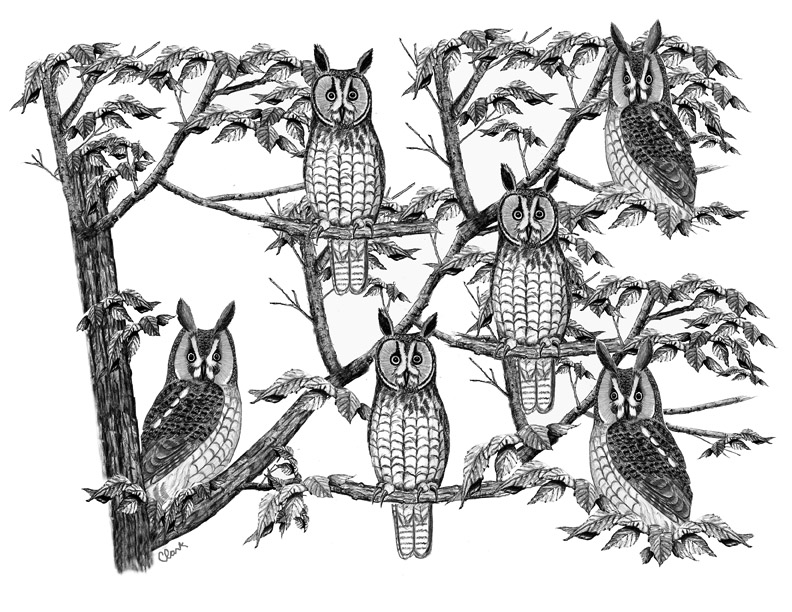
Long-eared Owls:
The readers who managed to survive last week’s storms may remember that my previous column was about an adventure I had finding a Long-eared Owl in Chatham. As usual, I rambled on so much that I wasn’t able to discuss the owl itself. So, this week I promise to write more about the owl, with only a minimal amount of rambling…maybe.
Long-eared Owls look very similar to the more common Great Horned Owls; the main difference is their body shape. Great-horns are stocky, robust birds while Long-eareds tend to be smaller and more slender. The contrast reminds me of Laurel and Hardy, or the skinny vs. fat Elvis. (Sorry about the outdated references, but my legal team suggests that I only make wisecracks about dead celebrities.) The key feature of the Long-eared Owl is, of course, its long ears. Although, their “ears” are really just tufts of feathers and have nothing to do with hearing, much in the same way Andy Rooney’s wild eyebrows had nothing to do with his vision. (Yup, another dead celebrity reference.)
Great Horned Owls are restricted to the Americas, but Long-eared Owls are also found in Europe, Asia and parts of Africa. They are active nighttime foragers, flying low over open fields and locating prey with their ears (their real ears and not the tufts). The ferocious Great Horned Owl will catch and eat just about anything from rabbits, to geese, to skunks, to housecats. But the Long-eared Owl’s diet consists mainly of mice, voles and other small mammals. The birds require open areas for hunting, but they prefer to roost in dense woods, which makes them nearly impossible to find without luck, or help.
About twenty winters ago (ramble alert!) Long-eared Owls were spotted roosting at the Daniel Webster Farm, in Marshfield. Even though these birds are notoriously tough to find, I decided to give it a shot. On my way to the Farm I stopped in the nearby town of Duxbury and picked up my birding buddy, Fahy (because when it comes to finding owls, four eyes are better than two.) Fahy told me that the owls had been seen in a dense stand of birch trees along the “Secret Trail.” (The Secret Trail is actually the trail’s name. I’m not trying to hide something from Wikileaks.)
We arrived at the birch grove and saw no signs of the owls. Since birds are always on the move, having patience is important (and not my strong suit). But with owls it’s different. They remain stationary during the day, so they are either there or they aren’t. They aren’t going to magically appear. After a five-minute search, Fahy and I gave up and decided it was time to go someplace else…and have a snack. As we continued down the trail we came upon another birder who had a spotting scope set up. I asked the guy if he had any luck with the owls, to which he replied, “Look in the scope.” I peered into the scope’s eyepiece and there, about twenty feet away, against a tree trunk, sat a Long-eared Owl. “I see it,” I told him, with a smile on my face. “You see ‘it’”? he questioned. “Better keep looking.” I leaned back over the scope and saw one, then two, then three, then… By they time I was done I had found six very well camouflaged Long-eared Owls, all within a few feet of each other. After Fahy had her turn viewing the owls, we thanked the guy for helping us and headed off. On the way back to the car, Fahy and I yapped about seeing the flock (aka, parliament) of owls. But even with all the excitement we had just experienced, we never lost focus of our next critical objective…going for that snack.
Great Horned Owls are basically misanthropes. They would rather eat each other then spend time socializing. But Long-eared Owls don’t mind each other’s company. A winter roost may contain as many as twenty birds. But the record for the largest roost belongs to a town in the country of Serbia. Over 750 Long-eared Owls regularly come to a small park and spend the day sleeping, preening and wondering why no one drives Yugos anymore.
The worldwide the population of Long-eared Owls appears to be fairly stable. Unfortunately for us Bay Staters, this owl is mostly a shy and uncommon winter visitor. Historical records suggest that there once was a time when long-eareds routinely nested in Massachusetts, but those days seem to be over. The most recent breeding bird survey found no nests at all, which makes the occasional sighting even more special.
Folks routinely ask me for the best way to find owls, but they never like my answer. Late night walks, or worse, going out before sunrise gives us the best chance of hearing an owl. But even if you get lucky and hear one, it’s going to be too dark to see the bird. (This is probably why everyone loves the diurnal Snowy Owl so much.) One method I use for finding owls during the day is to listen for crows, which will scream at a roosting owl every chance they get. Also, instead of looking up in the trees, I look down on the ground. The cryptic owls are nearly impossible to spot, but the whitewash they leave on the ground gives them away. And if none of those tricks work, look for a birder with a scope. That’s what works the best for me.
I know I say this a lot, but finding an unusual bird is what makes bird watching such a fun activity. It’s my excuse to go for a walk in the woods, breathe some fresh air, get needed exercise and at the end of it all, go someplace for a snack. Don’t forget that part.